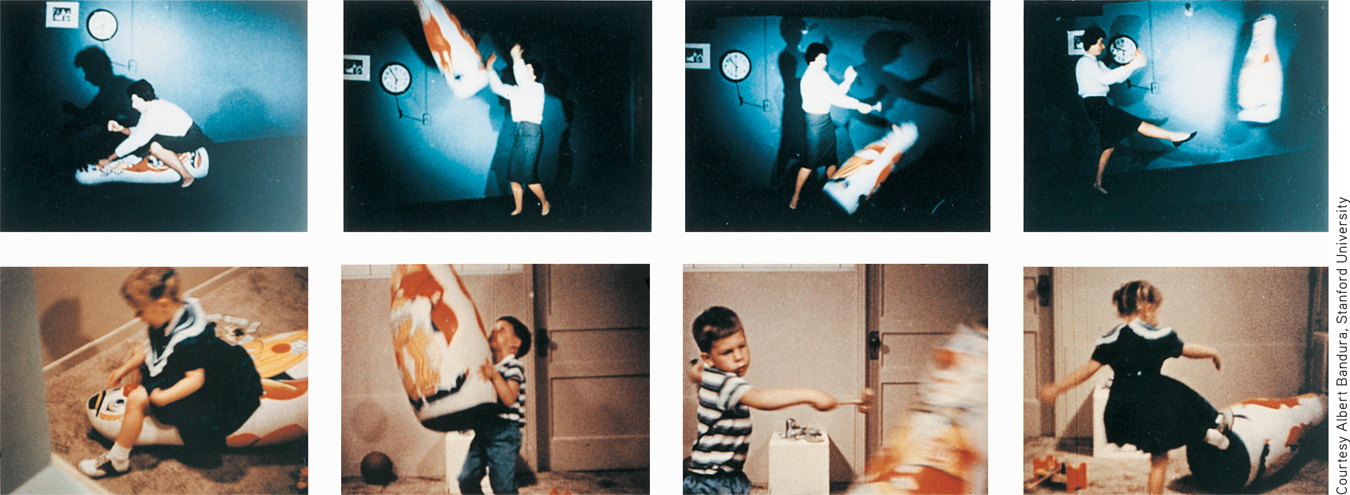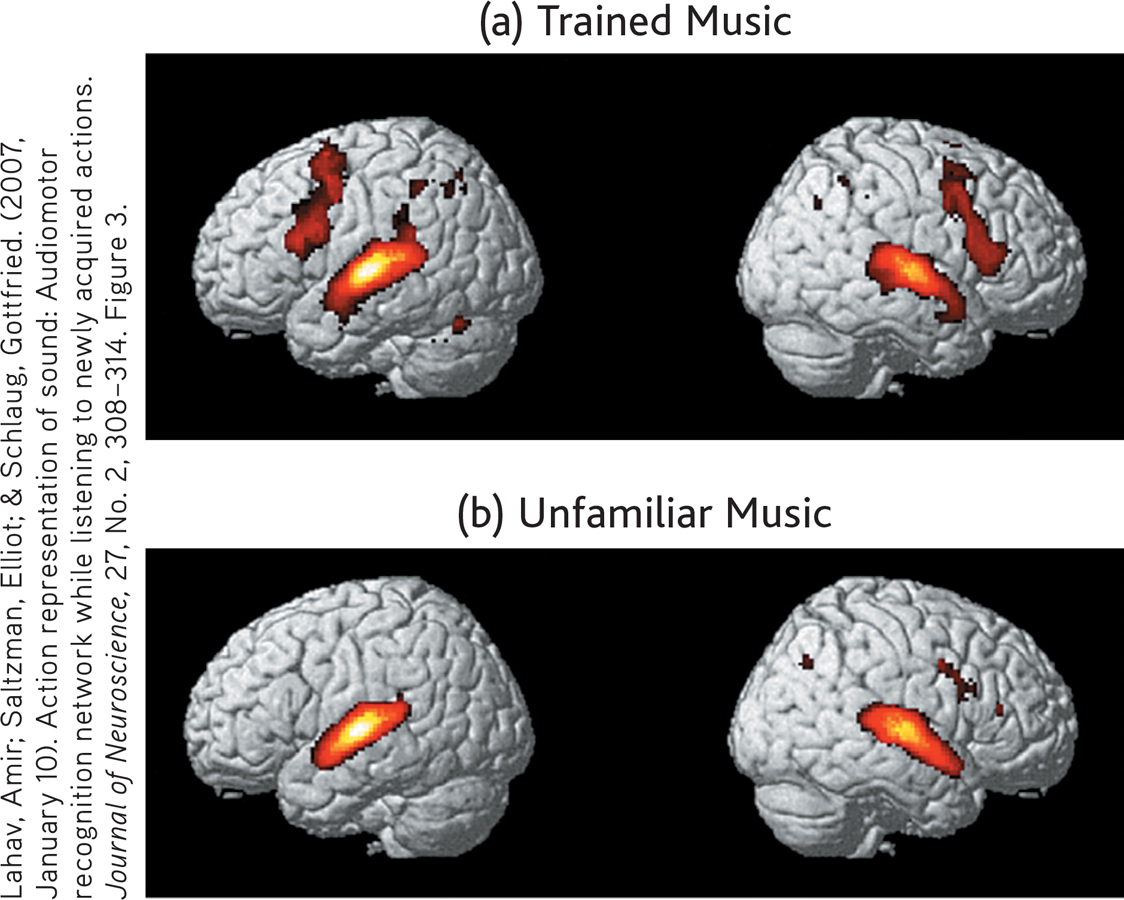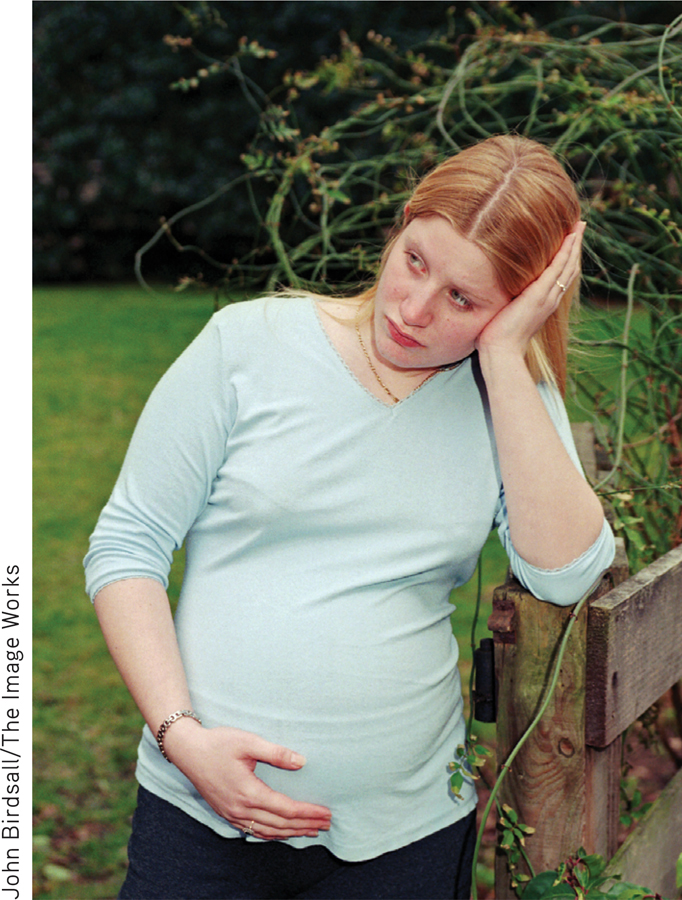5.6 Observational Learning: IMITATING THE ACTIONS OF OTHERS
KEY THEME
In observational learning, we learn through watching and imitating the behaviors of others.
KEY QUESTIONS
How did Albert Bandura demonstrate the principles of observational learning?
What four mental processes are involved in observational learning?
How has observational learning been shown in nonhuman animals?

Classical conditioning and operant conditioning emphasize the role of direct experiences in learning, such as directly experiencing a reinforcing or punishing stimulus following a particular behavior. But much human learning occurs indirectly, by watching what others do, then imitating it. In observational learning, learning takes place through observing the actions of others.
observational learning
Learning that occurs through observing the actions of others.
Humans develop the capacity to learn through observation at a very early age. Studies of infants, some as young as 2–
Albert Bandura is the psychologist most strongly identified with observational learning. Bandura (1974) believes that observational learning is the result of cognitive processes that are “actively judgmental and constructive,” not merely “mechanical copying.” To illustrate his theory, let’s consider his famous experiment involving the imitation of aggressive behaviors (Bandura, 1965). In the experiment, four-year-old children separately watched a short film showing an adult playing aggressively with a Bobo doll—a large, inflated balloon doll that stands upright because the bottom is weighted with sand. All the children saw the adult hit, kick, and punch the Bobo doll in the film.
However, there were three different versions of the film, each with a different ending. Some children saw the adult reinforced with soft drinks, candy, and snacks after performing the aggressive actions. Other children saw a version in which the aggressive adult was punished for the actions with a scolding and a spanking by another adult. Finally, some children watched a version of the film in which the aggressive adult experienced no consequences.
!launch!

After seeing the film, each child was allowed to play alone in a room with several toys, including a Bobo doll. The playroom was equipped with a one-way window so that the child’s behavior could be observed. Bandura found that the consequences the children observed in the film made a difference. Children who watched the film in which the adult was punished were much less likely to imitate the aggressive behaviors than were children who watched either of the other two film endings.
Then Bandura added an interesting twist to the experiment. Each child was asked to show the experimenter what the adult did in the film. For every behavior they could imitate, the child was rewarded with snacks and stickers. Virtually all the children imitated the adult’s behaviors they had observed in the film, including the aggressive behaviors. The particular version of the film the children had seen made no difference.
Bandura (1965) explained these results much as Tolman explained latent learning. Reinforcement is not essential for learning to occur. Rather, the expectation of reinforcement affects the performance of what has been learned.

Bandura (1986) suggests that four cognitive processes interact to determine whether imitation will occur. First, you must pay attention to the other person’s behavior. Second, you must remember the other person’s behavior so that you can perform it at a later time. That is, you must form and store a mental representation of the behavior to be imitated. Third, you must be able to transform this mental representation into actions that you are capable of reproducing. These three factors—attention, memory, and motor skills—are necessary for learning to take place through observation.
Fourth, there must be some motivation for you to imitate the behavior. This factor is crucial to the actual performance of the learned behavior. You are more likely to imitate a behavior if there is some expectation that doing so will produce reinforcement or reward. Thus, all the children were capable of imitating the adult’s aggressive behavior. But the children who saw the aggressive adult being rewarded were much more likely to imitate the aggressive behavior than were the children who saw the adult punished. TABLE 5.6 summarizes other factors that increase the likelihood of imitation.
Factors That Increase Imitation
| You’re more likely to imitate: |
| • People who are rewarded for their behavior |
| • Warm, nurturing people |
| • People who have control over you or have the power to influence your life |
| • People who are similar to you in terms of age, sex, and interests |
| • People you perceive as having higher social status |
| • When the task to be imitated is not extremely easy or difficult |
| • If you lack confidence in your own abilities in a particular situation |
| • If the situation is unfamiliar or ambiguous |
| • If you’ve been rewarded for imitating the same behavior in the past |
| Source: Research from Bandura (1977, 1986, 1997). |
Many nonhuman animals have been shown to learn new behaviors through observation and imitation (Reader & Biro, 2010). The ability to learn a novel behavior through observation has been demonstrated in many different species of animals from hamsters to ring-tailed lemurs (Lupfer & others, 2003; Kendal & others, 2010). Even guppies can learn foraging behavior and escape routes from other guppies (Reader & others, 2003).
Question 5.23
Ye2hCLpoazpe0l0eRwjeI/yk3M5VqddqcZNo8BoeYaePyouT4LoUg1SSZ1SBK/7rKjUv/n03vsB21d40Dh+ESwhcFVAGz4aDM6o64wzPymE1GdwIB47G1FyUiKQa8Mq1NSbD9y6T4/iEkhxGTRcZZpB0Mm4soTJBEsMUE7TbsDSRxdjRG+fYDEdg9uc7t9K/KvzSDkEmSV+Rna0ov7/8i2GjyIUzbrshHb3Up3JXz/J4UXtFnjZiTcDLX0KNrIFlZBb/CToxHwj9R6bciyrIyAVN6vmVHFxfpHO1akgsrzpxnncu6hcIbi4CrvohBuAlflWZ0JDGDRB7W49QlkyTQt6MVmdP7Eruqd0I1CDb4LlkWjFXFOCUS ON NEUROSCIENCE
Mirror Neurons: Imitation in the Brain
Psychologists have only recently begun to understand the neural underpinnings of the human ability to imitate behavior (Glenberg, 2011). The first clue emerged from an accidental discovery in a lab in Palermo, Italy, in the mid-1990s. Neuroscientist Giacomo Rizzolatti and his colleagues were studying neurons in the premotor cortex of macaque monkeys. Using tiny electrodes to record the activity of individual neurons, Rizzolatti’s team had painstakingly identified the specific motor neurons involved in simple behaviors, such as picking up a peanut or grabbing a toy (see Rizzolatti & Sinigaglia, 2008).
As one of the wired-up monkeys watched a lab assistant pick up a peanut, a neuron fired in the monkey’s brain—the same neuron that fired when the monkey itself picked up a peanut. At first, the researchers thought that the monkey must be making tiny muscle movements, and that these movements were responsible for the motor neuron activity. But the monkey was sitting perfectly still. The researchers were baffled because a motor neuron was thought to fire only if a motor behavior was occurring.

As you compare the scans in (a) and (b), notice the extensive activation in motor-related brain regions when the participants listened to the music that they had already learned to play, as in (a). However, these motor areas were not activated when they listened to the unfamiliar music that they had never played, as in (b).
The explanation? Rizzolatti’s team had discovered a new class of specialized neurons, which they dubbed mirror neurons. Mirror neurons are neurons that fire both when an action is performed and when the action is simply perceived (Iacoboni, 2009). It’s important to note that mirror neurons are not a new physical type of neurons. As described in Chapter 2, a mirror neuron is defined by its function, not its physical structure. In effect, these neurons imitate or “mirror” the observed action as though the observer were actually carrying out the action.
mirror neurons
Neurons that activate both when an action is performed and when the same action is perceived.
A decade of research has shown that mirror neurons do not simply reflect visual processing, but are also involved in mentally representing and interpreting the actions of others (Glenberg, 2011; Michael & others, 2014). For example, Evelyne Kohler and her colleagues (2002) showed that the same neurons that activated when a monkey cracked open a peanut shell also activated when a monkey simply heard a peanut shell breaking.
Following their discovery in the motor cortex, mirror neurons have since been identified in many other brain regions (see Hunter & others, 2013; Iacoboni, 2009). Today, many psychologists use the term mirror neuron system to describe mirroring in the brain. That’s because even simple behaviors and sensations often involve groups of mirror neurons firing together rather than single neurons firing separately (Cattaneo & Rizzolatti, 2009).
Evidence of Human Mirror Neurons
Brain imaging studies like the one illustrated at right have provided indirect evidence of mirror neurons in the human brain (see Oberman & Ramachandran, 2007; Slack, 2007). New studies have provided direct evidence for the existence of mirror neurons in humans (see Molenberghs & others, 2012; Mukamel & others, 2010).
Beyond imitation and observational learning, the mirror neuron system may play a role in empathy, language, and social cognition (Gallese & others, 2011; Lago-Rodriguez & others, 2013). And, some neuroscientists believe that dysfunctions in the mirror neuron system may contribute to autism and other disorders that are associated with impaired social functioning (Perkins & others, 2010). Although these speculations are intriguing, more scientific evidence is needed before such conclusions can be drawn (Decety, 2010; Fan & others, 2010).
Chimpanzees, apes, and other primates are quite adept at learning through observation. Just as with humans, motivational factors influence observational learning. One study involved imitative behavior of free-ranging orangutans in a preserve located in central Indonesia (Russon & Galdikas, 1995). The orangutans imitated the behavior of both humans and other orangutans, but they were more likely to imitate high-status or dominant models than low-status models. The orangutans were also more likely to imitate models with whom they had close relationships, such as biological parents, siblings, or their human caregivers. Human strangers were virtually never imitated.

Question 5.24
4hj4dAzDsbc0sq2S9VhdGkgVAUlywqrlz0i3znGj/Ryagbu0paz0rrG/SINvBUhO9xa2mt/10Azg0hUFmytYurYgMURy4sLdRWgC6vI4Cq1yIzsFR7Yt7UOBtp8k4XUrzvbYKaB+hX2db3+s4SKq2tRhzv3wnV0XXIsbyJtY/62BfCHpd7g1Sh29Dj5A2BQFSVICflimsA+f/NChH9qUTeJuPteGJoLs8FPeGXpoN2aAVsdF5t9P3we9uK+dtfpGZ71y6VRF4XHPRZeIg4jnyy7ketWJBAFYVeh3zwAbNP8/H0EDxmRGhZxgP+c/mDHd5JFWEFsSHSV4RL57//35ZYzsAy1zjKe/Applications of Observational Learning
Bandura’s finding that children will imitate film footage of aggressive behavior has more than just theoretical importance. One obvious implication has to do with the effects of negative behaviors that are depicted in films and television shows. Is there any evidence that television and other media can increase negative or destructive behaviors in viewers?
One recent study conducted by psychologist Rebecca Collins and her colleagues (2004) examined the impact of television portrayals of sexual activity on the behavior of U.S. adolescents between the ages of 12 and 17. Over the two-year period of the study, researchers found that adolescents who watched large amounts of television containing sexual content, such as Friends and That ‘70s Show, were twice as likely to begin engaging in sexual intercourse in the following year as adolescents who were the same age but watched the least amount of sexually oriented programming.

What about exposure to more explicit sexual content, such as pornographic or sexually explicit Web sites on the Internet? One study found that adolescents who visited such sites were more likely to have multiple sexual partners and to have used alcohol or drugs during their most recent sexual experience (Braun-Courville & Rojas, 2009).
Another important implication of Bandura’s research relates to the effects of media depictions of violence on behavior. In the Critical Thinking box, we take an in-depth look at the relationship between media portrayals of violence and aggressive behavior.
Given the potential impact of negative media images, let’s look at the flip side. Is there any evidence that television and other media can encourage socially desirable behavior?
Consider the widely viewed MTV reality series, 16 and Pregnant, which features the struggles of pregnant teens and young mothers. Some commentators feared that the show was glamorizing teenage pregnancy. However, researchers Melissa S. Kearney and Phillip B. Levine (2014) found that teen birth rates in areas where the show was aired dropped 5.7 percent in the 18 months after its introduction. They also surveyed Google searches and social media. They found thousands of tweets and large spikes in Google searches for information about birth control shortly after each episode aired. It’s important to note that the study is correlational, so it’s impossible to say that viewing the TV show directly caused a drop in teen pregnancy. However, the findings highlight ways in which media can influence social outcomes in positive ways.
CRITICAL THINKING
Does Exposure to Media Violence Cause Aggressive Behavior?
Bandura’s early observational learning studies showed preschoolers enthusiastically mimicking the movie actions of an adult pummeling a Bobo doll. His research provided a powerful paradigm to study the effects of “entertainment” violence. Bandura found that observed actions were most likely to be imitated when:
They were performed by a model who is attractive and who has high status or is a dominant member of the viewer’s social group.
The model is rewarded for his or her behavior.
The model is not punished for his or her actions.
Over the past four decades, more than 1,000 studies have investigated the relationship between media depictions of violence and increases in aggressive behavior in the real world (see Bushman & Anderson, 2007). We’ll highlight some key findings here.
How Prevalent Is Violence on Television in the United States?
An alarming amount of violence is depicted on television in the United States. On average, American youth witness 1,000 rapes, murders, and assaults on television annually (Parents Television Council, 2007). Violent behavior is portrayed in almost two-thirds of all television programs, and one-third of programs depict nine or more acts of violence (Smith & others, 2002). Evidence also suggests that the amount of violence shown on American television has increased over past decades (Hetsroni, 2007; Signorelli, 2005).
More troubling, much of the violent behavior is depicted in ways that are known to increase the likelihood of imitation. For example, violent behavior is not punished and is often perpetrated by the heroes or other “good guys.” And, most programs do not show the long-term consequences of violence.
Is Exposure to Media Violence Linked to Aggressive Behavior?
Numerous research studies show that exposure to media violence produces short-term increases in laboratory measures of aggressive thoughts and behavior. And, hundreds of correlational studies demonstrate a link between exposure to violent media and aggressive behavior both in and out of the classroom (see Bushman & Anderson, 2007; Huesmann & Taylor, 2006; Murray, 2008).
Reviewing the accumulation of decades of research evidence, the American Academy of Pediatrics issued a statement that echoed previous policy statements by other public health organizations, including the American Psychological Association and the American Medical Association. The conclusion: “Extensive research evidence indicates that media violence can contribute to aggressive behavior, desensitization to violence, nightmares, and fear of being harmed” (AAP Council on Communications Media, 2009). According to the U.S. Surgeon General, exposure to violent media is as important a risk factor for violence as poverty, substance abuse, and poor parenting (Bushman & others, 2009).
But Does Media Violence Cause Aggressive or Violent Behavior?
Brad Bushman and his colleagues (2009) reviewed five decades of research on the effects of media violence. The 300 studies included laboratory and field experiments, and cross-sectional and longitudinal studies involving over 50,000 participants. Their conclusion: “Exposure to violent media increases aggression and violence.”
However, many psychologists are more cautious in their conclusions about the effects of media violence (Elson & Ferguson, 2014; Ferguson & others, 2009). One important point is that violent behavior is a complex phenomenon that is unlikely to have a single cause.
It’s also important to note that the vast majority of studies on media violence and aggressive behavior are correlational (Ferguson & Kilbourn, 2009; Savage & Yancey, 2008). As you learned in Chapter 1, correlation does not necessarily imply causation. Even if two factors are strongly correlated, some other variable could be responsible for the association between the two factors. Experimental studies, on the other hand, are designed to demonstrate causality. However, most experimental studies involve artificial measures of aggressive behavior, which may not accurately measure the likelihood that a participant will act aggressively in real life.
Psychologists generally agree that some viewers are highly susceptible to the negative effects of media violence (see Huesmann & others, 2013). Some researchers think that the time has come to go beyond the question of whether media violence causes aggressive behavior and focus instead on investigating the factors that are most likely to be associated with its harmful effects (Feshbach & Tangney, 2008).
CRITICAL THINKING AND QUESTIONS
Given the evidence summarized here, what conclusions can you draw about the effect of violent media images on aggressive behavior?
Why is it so difficult to design an experimental study that would conclusively demonstrate that violent media causes aggressive behavior?
Given the general conclusion that some, but not all, viewers are likely to become more aggressive after viewing violent media, what should be done about media violence?


A remarkably effective application of observational learning has been the use of television and radio dramas to promote social change and healthy behaviors in Asia, Latin America, and Africa (Population Communications International, 2004). Pioneered by Mexican television executive Miguel Sabido, the first such attempt was a long-running serial drama that used observational learning principles to promote literacy among adults. The main storyline centered on the experiences of a group of people in a literacy self-instruction group. Millions of viewers faithfully watched the series. In the year before the televised series, about 90,000 people were enrolled in such literacy groups. In the year during the series, enrollment jumped to 840,000 people (Bandura, 1997).
Since the success of this program, the nonprofit group Population Communications International (2004) has developed over 240 “entertainment-education programs” in 27 different countries. Each series is developed with the input of local advisers and is written, produced, and performed by creative talent in the country of the intended audience. The long-running programs feature characters with whom the average viewer can easily identify. While the storylines are dramatic, they also reflect everyday challenges. Based on Bandura’s observational learning paradigm, these serial dramas motivate individuals to adopt new attitudes and behavior by modeling behaviors that promote family health, stable communities, and a sustainable environment.
Education-entertainment programs are designed to fulfill the optimal conditions for observational learning to occur (Bandura, 2002). The dramatic intensity, highly involving plot lines, and engaging characters ensure that viewers will become involved in the dramas and pay attention. To ensure that the modeled messages are remembered, an epilogue at the conclusion of each episode summarizes the key points and issues of the episode. To enhance the viewers’ ability to carry out the modeled behaviors, a variety of support programs and groups are put in place when the series airs. And motivating people to change their behaviors in line with the modeled behaviors is accomplished by depicting the benefits of doing so. Research studies have confirmed the highly successful impact of these extremely popular dramas (see Gesser-Edelsburg & others, 2010; Singhal & others, 2004).
Entertainment-education programs have also aired in the United States. For example, the radio program Entrelazado, which is Spanish for “Entwined,” was developed in Birmingham, Alabama, to encourage healthy behaviors, including prevention of obesity and tobacco use, among the local Hispanic population (Media for Health, 2011).
The serials dramatize the everyday problems people struggle with and model functional strategies and solutions to them. This approach succeeds because it informs, enables, motivates, and guides people for personal and social changes that improve their lives.
—Albert Bandura (2004a)
Beyond the effects of media depictions on behavior, observational learning has been applied in a wide variety of settings. The fields of education, vocational and job training, psychotherapy, counseling, and medicine use observational learning to help teach appropriate behaviors.
CONCEPT REVIEW 5.4
Learning Researchers and Processes
For each of the situations described, name the process involved (classical conditioning, operant conditioning, latent learning, instinctive drift, observational learning) and the psychologist(s) associated with it.
Question 5.25
| 1. | Lisa transfers to a new college and spends her first few days on campus getting oriented. A week later she decides to have lunch at the college cafeteria. Although she has never eaten there before, she has no problem finding it. |
Process ____________ Psychologist(s) ____________
Question 5.26
| 2. | Little Ben rarely brushed his teeth. Ben’s parents began giving him a sticker every time he brushed his teeth. Now, Ben brushes his teeth frequently. |
Process ____________ Psychologist(s) ____________
Question 5.27
| 3. | When Brittany’s grandmother gave her a toy broom, the two-year-old immediately tried to sweep the floor with it. |
Process ____________ Psychologist(s) ____________
Question 5.28
| 4. | One of Jordan’s first jobs as an animal trainer was to train a pig to pick up a coin and deposit it into a piggy bank. Through shaping and reinforcement with food, Jordan had some initial success, but soon the pig was more interested in pushing the coin along the ground with its snout than in putting it in the bank. |
Process ____________ Psychologist(s) ____________
Question 5.29
| 5. | Jan’s ex-husband always wore Old Spice aftershave. Five years after her divorce, Jan still cringes whenever she encounters someone who smells like Old Spice. |
Process ____________ Psychologist(s) ____________
Test your understanding of Observational Learning with
 .
.
Closing Thoughts
One theme throughout this chapter has been the quest to discover general laws of learning that would apply across virtually all species and situations. Watson was convinced that these laws were contained in the principles of classical conditioning. Skinner contended that they were to be found in the principles of operant conditioning. In a sense, they were both right. Thousands of experiments have shown that behavior can be reliably and predictably influenced by classical and operant conditioning procedures. By and large, the general principles of classical and operant conditioning hold up quite well across a wide range of species and situations.
But you’ve also seen that the general principles of classical and operant conditioning are just that—general, not absolute. Such researchers as John Garcia and Marian and Keller Breland recognized the importance of a species’ evolutionary and biological heritage in acquiring new behaviors. Other researchers, such as Edward Tolman and Robert Rescorla, drew attention to the important role played by cognitive processes in learning. And Albert Bandura’s investigations of observational learning underscored that classical and operant conditioning principles could not account for all learning.
Another prominent theme has been the adaptive nature of learning. Faced with an ever-changing environment, an organism’s capacity to learn is critical to adaptation and survival. Clearly, there are survival advantages in being able to learn that a neutral stimulus can signal an important upcoming event, as in classical conditioning. An organism also enhances its odds of survival by being responsive to the consequences of its actions, as in operant conditioning. And, by observing the actions and consequences experienced by others, behaviors can be acquired through imitation. Thus, it is probably because these abilities are so useful in so many environments that the basic principles of learning are demonstrated with such consistency across so many species.
In the final analysis, it’s probably safe to say that the most important consequence of learning is that it promotes the adaptation of many species, including humans, to their unique environments. Were it not for the adaptive nature of learning, Erv would probably have gotten trapped in the attic again!